Transcription
SURVIVAL AND BEYONDTHE DOMESTIC ABUSE REPORT 2017
AuthorsSarah Davidge and Lizzie MagnussonResearch and Evaluation Team, Women’s AidAcknowledgmentsWe are extremely thankful to all the domestic abuse services who have provided thevital data for this report.We are also grateful to the Ministry of Housing, Communities and Local Government(MHCLG) for its funding contribution to Routes to Support (the UK violence againstwomen and girls service directory run in partnership with Women’s Aid Federation ofNorthern Ireland, Scottish Women’s Aid and Welsh Women’s Aid) and the Women’sAid Annual Survey, and for its full funding of the No Woman Turned Away (NWTA)project. Data from all of these sources contribute to this report. This report wasindependently researched and written by Women’s Aid.Thanks also go to the staff at Women’s Aid for all their support.Published by:Women’s Aid Federation of EnglandPO Box 3245, Bristol, BS2 2EH Women’s Aid 2018ISBN 978-0-907817-38-3Please cite this report as:Women’s Aid (2018) Survival and Beyond: The Domestic Abuse Report 2017. Bristol: Women’s Aid.Photo credit:Page 4: Gus PalmerWomen’s Aid is the national charity working to end domestic abuse against women and children. Over the past 40years Women’s Aid has been at the forefront of shaping and coordinating responses to domestic violence and abusethrough practice. We empower survivors by keeping their voices at the heart of our work, working with and for womenand children by listening to them and responding to their needs. We are a federation of over 220 organisations whoprovide more than 300 local lifesaving services to women and children across the country. We provide expert training,qualifications and consultancy to a range of agencies and professionals working with survivors or commissioningdomestic abuse services, and award a National Quality Mark for services which meet our quality standards. Ourcampaigns achieve change in policy, practice and awareness, encouraging healthy relationships and helping to builda future where domestic abuse is no longer tolerated. The 24 Hour National Domestic Violence Helpline on 08082000 247 (run in partnership with Refuge) and our range of online services, which include the Survivors’ Forum, helphundreds of thousands of women and children every year.
ContentsForeword4Introduction5Section 1: Who are the service users?81.1: Our findings91.2: Ethnicity and age range101.3: Who is missing from the data?131.4: Perpetrators14Section 2: Meeting the needs of women and children152.1: Needs relating to children172.2: Health needs202.3: Justice-related needs222.4: Needs related to social and community relationships252.5: Finance and employment-related needs262.6: Immigration-related needs272.7: Housing-related needs29Section 3: What are the support services meeting these needs?323.1: Types of intervention provided by domestic abuse services333.2: Support services available343.3: Changes over time363.4: Is provision meeting need?403.5: Sustainability53Conclusion: Facing the challenges59References61Case studies65Appendix 1: Glossary of terms67Appendix 2: Service types offered68Appendix 3: Women’s Aid data sources70Appendix 4: Areas of need74
ForewordKatie GhoseChief Executive, Women’s AidDomestic abuse, by its very nature, ishidden behind closed doors. This makes theproduction of detailed information and theunpicking of the facts behind the headlinesall the more important. The more we canunderstand about survivors’ journeys and thevital specialist support they need, the betterwe can identify the gaps and what changes areneeded to ensure that all women are able toescape abuse and rebuild their lives.Our Domestic Abuse Report 2017 uniquelydraws upon five national data sources for thefirst time. Together they provide informationabout a range of domestic abuse servicesand their service users, including informationfrom community-based services (for example,prevention work, drop-in services, advocacyservices, counselling support) and from refugeservices. Sustainable funding has long been aproblem, but with 60% of respondents citingfunding insecurity as their top challenge,we have further evidence that a sustainablelong-term funding solution is vital. It mustincorporate the national network of refugeswe have built over the last 40 years, inorder to save the lives and futures of thoseexperiencing abuse. The report shows thefull range of services women and childrenrequire, from prevention work to crisis. Rightnow, many services feel they have insufficientresources to offer much more than crisissupport, and even then, many women areturned away because of a lack of capacity.We also know that the women who experienceabuse are all unique, and we can only trulysupport them by attending to their individualneeds. For example, about 78% of women inrefuge on our Day to Count had health supportneeds, over half had sustained physical injuryfrom the domestic abuse and over a third hadmental health support needs – in many casesthis will be combined with other complexneeds. We found that there are more childrenthan women in refuge, with 62% of womenbringing children with them, all with individualneeds of their own.Our limited services then face the challengesof supporting women into independence.Rehousing places a great deal of stresson survivors. This has a huge impact onchildren who are in need of a stable homeenvironment, having already suffered trauma.All the while, we must remember that survivorsare victims of crime – about two in five ofthose living in a refuge have had the abusereported to the police. Support through thecriminal justice system is vital if there is to beany recompense for their suffering and theperpetrator held responsible.This report gives us the most detailed pictureof service provision to date, offering usessential insights to give hope to our sector,and the hundreds of thousands of womenand children who suffer abuse at the hands ofviolent and controlling perpetrators.
IntroductionWomen’s Aid1 is the national charity workingto end domestic abuse against women andchildren in England. Women’s Aid holds fivenational data sources for England making usthe only organisation to gather evidence onthe full range of domestic abuse services inEngland and the experiences of women andchildren using them. We use our own evidencebase and work with academic partners to lookat the entire picture of women’s journeys andexperiences, including the responses theyreceive from agencies, in order to inform all ofour work.Survival and Beyond: The Domestic AbuseReport 2017 provides a review of domesticabuse support services in England and theneeds of women survivors and childrenusing them. Women’s Aid has carried out anannual survey of domestic abuse services inEngland for many years and reports from thesurveys going back to 2010 are available onthe Women’s Aid website2. This year, for thefirst time, we are building on the findings ofour annual survey by combining the resultsof the Women’s Aid Annual Survey 2017with data from our other major sources. Thecombination of these rich evidence basesgives us an invaluable insight into the needsof women and children experiencing domesticabuse and the challenges faced by the servicessupporting them.This report explores:ff the women using domestic abuse servicesand their needs;ff the scope, nature and sustainability ofdomestic abuse service provision; andff how a lack of resources or capacity to meeta woman’s (or her child’s) specific supportor access needs can create barriers toescaping – and recovering from – domesticabuse.What is included in this report?We mainly focus on the financial year 2016/17and the results of a census day and week inJuly 2017 (called the Day and Week to Count).In addition, this report examines some datafrom previous years to draw out any trendsbetween 2010 and 2017. In short, this is thefirst report by Women’s Aid that uses datafrom all five of our major data sources (seeAppendix 3 for more information). The reportalso references other research which supportsour data or can provide further detail. A full listis included in the references.The following Women’s Aid data sources wereused in this report:ff Routes to Support3, the UK violenceagainst women and girls database ofservice and refuge vacancies run inpartnership by Scottish Women’s Aid, WelshWomen’s Aid, Women’s Aid Federationof England and Women’s Aid Federationof Northern Ireland. This report includesdata for England and additional data onvacancies from London refuges4 telling usabout the women accessing refuge and1Women’s Aid Federation of t4This data collection is supported by London Councils.
6Survival and Beyond: The Domestic Abuse Report 2017the instances of unsuccessful referrals forthese vacancies.ff The Women’s Aid Annual Survey 20175of domestic abuse services in England. Thesurvey provides insight into the challengesservices face throughout the year andinformation on the women they supportfrom a Day and Week to Count (a censusday and week). Both Routes to Supportand the annual survey are part-funded bythe Ministry of Housing, Communities andLocal Government.We also include data from the followingsources:ff On Track6, our case management andoutcomes monitoring database. On Trackwas launched in March 2016 and is alreadyused by over 40 local service providersthroughout England. Services contributeto a national dataset which providesinformation on women’s experiences ofabuse, support offered by services, andoutcomes achieved. 11,113 cases of femaleclients were recorded in 2016/17.partnership with Women’s Aid, with supportfrom Freshfields Bruckhaus Deringer LLPand Deloitte LLP. The Femicide Census is adatabase currently containing informationon over one thousand women killed bymen in England and Wales since 2009. Thelatest report8 was published in December2017.The appendices to this report provide detailson methodologies used in our research and aglossary that includes definitions of the termsused in this report including: service provider,entry, bed space and service type. In thisreport we use data received from respondentsto the 2017 annual survey to estimate thenumbers of women and children supportedor turned away from services during the year.Details of how these estimates are calculatedcan be found in Appendix 3: Women’s Aid datasources.Quotes used in this report (unless otherwisestated) are from domestic abuse servicesresponding to the Women’s Aid Annual Survey2017.ff The No Woman Turned Away project, afrontline telephone-based support servicefor women who were unable to accessrefuge. This project has been funded bythe Ministry of Housing, Communities andLocal Government and provides us withvaluable information on barriers womenface when trying to flee to refuge, whichhas been published in our report Nowhereto Turn7.ff The Femicide Census, which has beendeveloped by Karen Ingala Smith in5The Women’s Aid Annual Survey is sent to all domestic abuse services in England and asks questions about the previousfinancial year and service use on a Day to Count (for refuge services) and Week to Count (for community-based services).Previous annual survey reports can be found at: ng-and-influencing/femicide-census
Survival and Beyond: The Domestic Abuse Report 2017What is domestic abuse?Women’s Aid defines domestic abuse as anincident or pattern of incidents of controlling,coercive, threatening, degrading and/orviolent behaviour (including sexual violence),by a partner or ex-partner, family memberor carer. For the women experiencing thisabuse it is often not a series of isolatedincidents, rather a pattern of behaviour andcontrol which can last many years, or evendecades. Domestic abuse of women by menis very common. During the year endingMarch 2017, there were an estimated 1.2million women who experienced domesticabuse in England and Wales (ONS, 2017B).Coercive and controlling behaviour is atthe heart of domestic abuse and has beena specific criminal offence since the endof 2015. Coercive control is defined instatutory guidance as, “a purposeful patternof behaviour which takes place over timein order for one individual to exert power,control or coercion over another” (HomeOffice, 2015). These are abusive actionsdesigned to limit a person’s freedom andautonomy and to dictate most aspects ofa survivor’s everyday life (Kelly et al, 2014;Myhill & Hohl, 2016; Schechter, 1982; Stark,2007; Women’s Aid, 2016).Women’s Aid recognises domestic abuse as“ violence that is directed against a womanbecause she is a woman or that affectswomen disproportionately” (CEDAW, 1992).Domestic abuse is deeply rooted in thesocietal inequality between women and menand in enduring notions of masculinity andfemininity. The sexual inequality at the heartof domestic abuse intersects with otherforms of discrimination, such as racism,homophobia, and disability discrimination.Black and minority ethnic survivors, lesbianand bisexual survivors and disabled survivorsoften face additional challenges in gettingsupport, escaping abuse and receiving justicefor the abuse they have experienced.All victims should be able to accessappropriate support. There are importantdifferences between male violence againstwomen and female violence against men,namely the amount, severity and impact.Women experience higher rates of repeatedvictimisation and are much more likely to beseriously hurt (Walby & Towers, 2017; Walby& Allen, 2004) or killed than male victims ofdomestic abuse (ONS, 2017B). Further tothat, women are more likely to experiencehigher levels of fear and are more likely tobe subjected to coercive and controllingbehaviours (Dobash & Dobash, 2004; Hester,2013; Myhill, 2015; Myhill, 2017).Domestic homicide and prosecution statisticshighlight these differences in experiences ofdomestic abuse. In the year ending March2017 the large majority of defendants indomestic abuse-related prosecutions weremen (92%), and the majority (65%) of victimswere recorded as female (13% of victimswere male and in 21% of prosecutions thesex of the victim was not recorded) (ONS,2017B).From April 2013 to March 2016, 70% ofdomestic homicide victims were women. Theoverwhelming majority of female domestichomicide victims were killed by men; therewere male perpetrators in 96% of cases,and female perpetrators in 3% of cases (11cases, in eight of which the woman was killedby her mother). In 1% of cases there wereno suspect details available. 242 of the 246women killed by partners/ex-partners werekilled by men, one by a woman, and for threefemale victims there were no suspect detailsavailable.The majority of male domestichomicide victims were also killed by men(66% of male victims were killed by men and34% by women). 32 of the 72 men killed bypartners/ex-partners were killed by men and40 were killed by women (ONS, 2017B).
Section 1:Who are theservice users?Women’s Aid is the national charity workingto end domestic abuse against women andchildren. As such, this report centres onwomen survivors and the services supportingthem. All figures used in this report relate towomen and, where relevant, their children.1Of the domestic abuse services listed onRoutes to Support in England, 154 (42%) alsooffer support to male survivors of domesticabuse, including 22 services which offer refuge.This number does not include those servicesoffering support for male survivors only.Domestic abuse service users includewomen and children from a wide range ofbackgrounds with diverse needs. The majorityof women staying in refuge have children withthem, and community-based services alsooffer support, directly and indirectly, to largenumbers of children.1Respect, the UK membership organisation for work with domestic violence perpetrators, male victims of domesticviolence and young people’s violence in close relationships, has a range of resources for those working with men whohave experienced domestic violence including a toolkit, training and the national helpline, the Men’s Advice Line, whichoffers information, practical advice and emotional support to male victims, as well as to their friends and family andfrontline workers. respect.uk.net
1.1 Our FindingsDay to CountWeek to CountTuesday 4th July 2017 (refuge services)Monday 3rd July – Friday 7th July 2017inclusive (community-based services)Women’s Aid Annual Survey 2017Respondents to our survey told us that on theDay to Count2:ff 2,182 women and 2,336 children and youngpeople (aged under 18) were resident intheir refuge services.Based on our respondents’ answers3:ff We estimate that there were 3,557 womenwith 3,919 children and young peoplestaying in refuge on the Day to Countacross all services in England.ff Over the year 2016/17, we estimate refugeservices supported a total of 13,414 womenwith 14,353 children and young peopleacross all services in England.Women’s Aid Annual Survey 2017Respondents to our survey4 told us that duringthe Week to Count:ff 12,175 women were supported in theircommunity-based services.5ff 2,101 children and young people (agedunder 18) directly supported.6ff 12,703 children and young people (agedunder 18) indirectly supported.7Based on our respondents’ answers:ff We estimate that there were 25,727women using community-based servicesin the Week to Count across all services inEngland.ff We estimate that 154,306 women usedcommunity-based services during the year2016/17 across all services in England.Our sample for the Women’s Aid AnnualSurvey 2017 Day to Count comprised 2,182women resident in refuge services. For theannual survey’s Week to Count, we collectedinformation from a sample of 12,175 womenusing community-based services. This annualsurvey data shows the diversity of domesticabuse service users, with some commonthemes in their experiences of abuse and theirsupport needs.2105 refuge services responded to this section of the survey. The actual numbers of women resident in refuge servicesthat day will be greater because not all services responded to the survey.3Estimates are based on responding services, see Appendix 3: Women’s Aid data sources for detail.482 community-based services responded to this section of the survey. The actual numbers of women using communitybased services that week will be greater because not all services responded to the survey.5Floating support, outreach or advocacy services.6Directly supported via children/young people’s workers.7Indirectly supported through support given to the mother.
women resident in refuge services. For the annual survey’s Week to Count, wecollected information from a sample of 12,175 women using community-basedservices. This annual survey data shows the diversity of domestic abuse service users,with some common themes in their experiences of abuse and their support needs.1.2 Ethnicity and age rangeEthnicity and age rangeDuring the Day and Week to Count, women using domestic abuse services were mostlyaged between 21 and 40. (See Chart 1). However, there was large amount of missingdata for the community-based services sample (for 30.9% of women no age was given).During the Day and Week to Count, women using domestic abuse services were mostly agedbetween 21 and 40 (see Chart 1). However, there was a large amount of missing data for theChart 1: Age groups of women supported during the day and Week to Count 2017 (Women’s Aidcommunity-based services sample (for 30.9% of women no age was given).Annual Survey 5%12.1%20%8.6%18.5%25%12.0%30%22.2%35%0.7%0.9%% of total number of womenChart 1: Age groups of women supported during the Day andWeek to Count 2017 (Women’s Aid Annual Survey 2017)Age groupsCommunity-based services (out of 12,175)Refuge services (out of 2,182)Women from the under 18 and over 60 agedomestic abuse in the last year (ONS, 2017B).groupsWomenappearfromto betheunder-representedHowever,only0.7%and 0.9% of serviceunder 18 and overin60ourage groupsappearto beunder-representedin userssampleourof samplewomenofusingservices.This cannotin community-basedand womenrefuge serviceswomenusing services.This cannotbe taken to mean thatinbe taken to mean that women in these agerespectively in the Week and Day to Countthese age groups are not experiencing domestic abuse.groups are not experiencing domestic abuse.were in the age group ‘16 and 17 years‘. Thismay be because young people do not seeData from the Crime Survey of England andadult domestic abuse services as relevant forPage11 of 83Wales (a nationally representative survey)them and prefer online servicesratherthanshow that of all the age groups surveyed (fromaccessing more traditional support, such asage 16 to 59 years), adults aged 16 to 19 werehelplines and face-to-face services.8the most likely to say they had experienced8Data on the usage of Childline suggest that children and young people are more confident talking about sensitive issuesonline. In 2015/16, 71% of concerns were communicated to Childline via the online counselling channel compared with29% via the voice counselling channel (NSPCC, 2016).
11Survival and Beyond: The Domestic Abuse Report 2017As in previous annual survey findings, olderwomen are very under-represented inservice use, despite evidence to suggest thatolder women experience domestic abuse atsimilar rates to younger women (Blood, 2004;Femicide Census, 2016 and 2017; Mouton etal, 2004). For example, the Femicide Censusshows that 8% (n 6) of the women killed by apartner or ex-partner in 2016 were aged 66 orover so we know that domestic abuse affectswomen of all ages (Femicide Census, 2017).Only 3.5% of community-based service usersand 1.7% of refuge residents were aged 56 andover. This raises important questions abouthow services can reach out to older survivorsand adapt their services to be welcoming andsuitable for older women.Service users in the Day and Week to Countcame from diverse ethnic backgrounds (seeTable 1, overleaf). The ethnic group with thehighest number of women was the ‘WhiteBritish’ ethnic group (50.4% of communitybased service users, 42.2% of refuge residents).The second highest numbers were for the‘Asian/Asian British Pakistani’ (10.4%) ethnicgroup for refuge services and ‘Any other Whitebackground’ ethnic group for communitybased services (6.0%). These numbers should,however, be treated with caution becausethere are large numbers of missing data forthe community-based services sample (for9.3% of women the ethnic group had beenreported as unknown and for 10.5% no datawere given on ethnicity). For the refuge samplethere were also missing data (for 8.3% ofwomen no data were given for ethnic groups).
12Survival and Beyond: The Domestic Abuse Report 2017Table 1: The ethnic backgrounds of service users during the Day and Week to Count 2017Community-basedRefuge servicesservices (out of 12,175) (out of 2,182)White British50.4%42.2%White Irish0.8%0.4%White Gypsy or Irish Traveller0.4%0.5%White any other background6.0%5.1%Mixed/multiple ethnic group White and Black1.4%CaribbeanMixed/multiple ethnic group White and Black0.4%African3.1%1.1%Mixed/multiple ethnic group White and Asian 0.4%0.8%Mixed/multiple ethnic group any otherbackground1.1%1.4%Asian/Asian British Indian1.7%2.7%Asian/Asian British Pakistani3.5%10.4%Asian/Asian British Bangladeshi0.9%3.3%Asian/Asian British Chinese0.6%0.2%Asian/Asian British any other background1.8%3.8%3.8%6.8%2.3%3.1%1.9%2.0%Other ethnic group Arab0.5%1.6%Any other ethnic group2.2%2.5%Ethnic group unknown9.3%0.8%Missing data10.5%8.3%Black/African/Caribbean/Black BritishAfricanBlack/African/Caribbean/Black BritishCaribbeanBlack/African/Caribbean/Black British anyother background
1.3 Who ismissing from the data?Our data sources provide us with a widerange of evidence allowing us to exploreservice provision and the needs of women andchildren survivors. Appendix 3 to this reportgives detail on the response rate and extentand limitations of our data sources, includingthe annual survey.or space, or a lack of resources to meet thatwoman’s specific needs. It is clear from ourresearch findings that demand is exceedingwhat support services can currently offer, andthis seems to be especially the case for refugeservices. This is discussed in detail in Section3.4: Is provision meeting need?It is important to note that, however extensiveour evidence base is, there will always besome survivors who are missing from thedata, meaning that they do not present the fullpicture of how many women from differentage groups and different social backgroundsexperience abuse.As discussed previously, age can presentchallenges for women accessing services.Older women are absent from our figureson service users. This is despite evidence tosuggest that domestic abuse is just as much ofan issue for older women as it is for youngerwomen. Younger women in their teenage yearsare also under-represented in our Day andWeek to Count service use statistics.Some survivors may never disclose that theyare experiencing abuse or seek supportfrom a domestic abuse service, or they mayconsiderably delay disclosing, maybe for yearsor even decades. Some survivors may discloseabuse to someone, but are not believed ortaken seriously, or not referred to specialistsupport. Data taken from On Track’s nationaldataset showed that, shockingly, 13% ofservice users had experienced abuse for 20years or more9 (Women’s Aid, 2017C). Onestudy of black and minority ethnic (BME)domestic abuse service users found thata large number of survivors from a BMEbackground were trapped in relationshipsby violent perpetrators for a long time; 26%(n 48) had been in a violent relationship for20 years or more; 18% (n 33) for five years ormore (Thiara & Roy, 2012).Some research on the impact of domesticabuse on specific groups is available (forexample, see the work of Imkaan10: www.imkaan.org.uk/resources).To fully understand the impact of domesticabuse there needs to be more focusedresearch into the experiences of certain groupsof survivors who are often under-representedin reports on domestic abuse, including lesbianand bisexual women, trans women, olderwomen, disabled women and women fromsome minority ethnic groups.In addition, some women who are referred,or who self-refer, to domestic abuse supportservices are declined from support for avariety of reasons, including a lack of capacity9Out of 1,217 female survivors supported by 25 domestic abuse services between 1st April 2016 and 31st March 2017.10 Imkaan is a UK-based, black feminist organisation representing specialist services led by and for black and minorityethnic (BME) women affected by violence against women and girls.
1.4 PerpetratorsAnonymised national data gathered from OnTrack (the Women’s Aid case managementand outcomes monitoring system11) showthat the perpetrators in female experiencesof domestic abuse are usually male. On Trackdata12 relating to female service users showedthat the overwhelming majority (93.6%) of thealleged perpetrators were male and 4.0% werefemale (in addition, 2.4% were missing data or‘don’t know/not asked’). See Table 2.Table 2: The sex of the alleged perpetratorin cases of female domestic abuse serviceusersSex of allegedperpetrator% of total ofrecords of allegedperpetratorsMissing data1.9%Don't know/not asked0.5%Female4.0%Gender queer0.0%Intersex0.0%Male93.6%Other0.0%Total100%11 On Track allows frontline workers in local domestic abuse services to record information about service users.12 Out of a total records of 9,766 alleged perpetrators in the financial year 2016/17. Data extracted December 2017. Fromrecords for 8610 clients where alleged perpetrator/s is recorded.
Section 2:Meeting theneeds ofwomen andchildrenThe Women’s Aid Annual Survey 2017 askedquestions about different categories of needidentified by the women using domesticabuse services (see Appendix 4 for the areasof need). Addressing needs is at the heart ofthe Women’s Aid Change that Lasts approach.This approach is centred on recognising andaddressing the needs of survivors of domesticabuse and working with women’s ownstrengths to promote their safety, freedomand independence. It puts the emphasis forsupport on providing survivors with options,giving them control and focusing on recoveryfrom the long-term lasting effects of domesticabuse.It is clear from the annual survey findings thatdomestic abuse services are working withwomen who have a diverse range of needs(see Chart 2) and this section of the reportwill explore these different areas of need inmore detail. As previously noted and exploredfurther in Section 3, there remains a lot ofunmet need and many services do not havethe funding or resources to meet the specificneeds of all women who wish to access theirservice.A large number of survivors using servicesduring the Day and Week to Count reportedexperiencing coercive control (see page 7 formore information on coercive and controllingbehaviour). During the Day and Week toCount, 74.5% of refuge service users and50.9% of community-based service usersreported having experienced or experiencingcoercive controlling behaviour. However,the actual numbers may be greater becausesome women may not recognise the abusivebehaviours they were experiencing as part ofa pattern of control, or they may even blamethemselves for the abuse.
16Survival and Beyond: The Domestic Abuse Report 2017Chart 2: needs of service users during the Day and Week toCount 2017 (Women's Aid Annual Survey 2017)100%90.5%90%% of total number of .4%0%Areas of needRefug
Survival and Beyond: The Domestic Abuse Report 2017 provides a review of domestic abuse support services in England and the needs of women survivors and children using them. Women's Aid has carried out an annual survey of domestic abuse services in England for many years and reports from the surveys going back to 2010 are available on
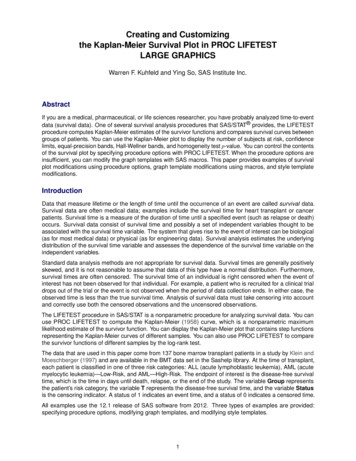




![[ST] Survival Analysis - Stata](/img/33/st.jpg)
